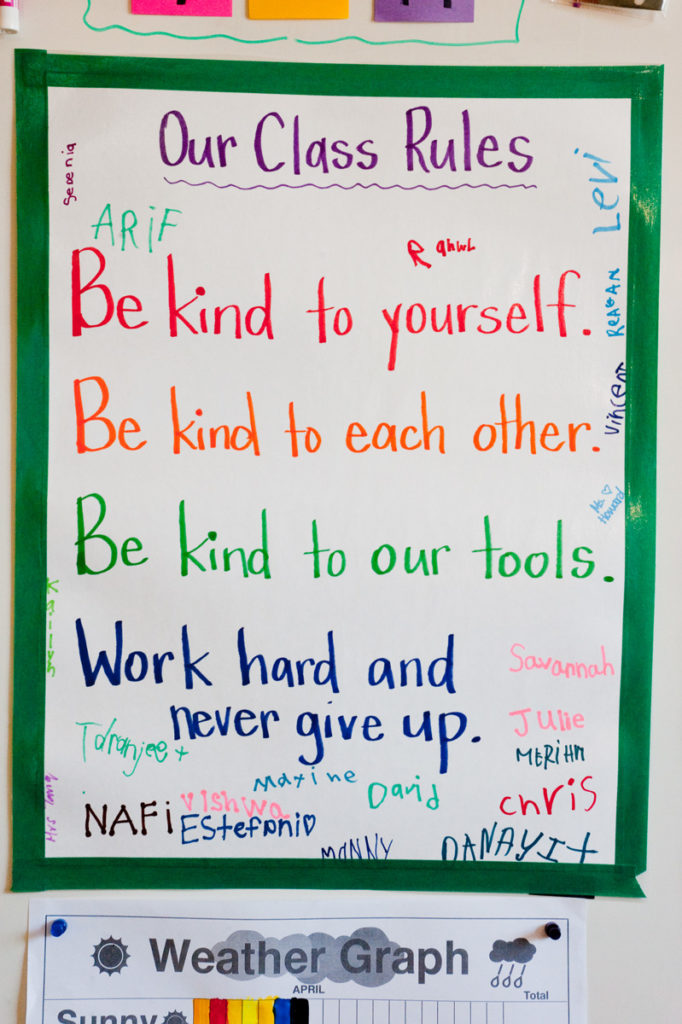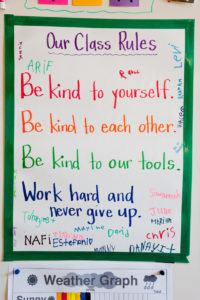
 In many classrooms, after the children and teacher create classroom rules during the first weeks of school, they revisit the rules at various points during the year. When do you do this with your students, and what’s your purpose and process?
In many classrooms, after the children and teacher create classroom rules during the first weeks of school, they revisit the rules at various points during the year. When do you do this with your students, and what’s your purpose and process?A: In addition to calling attention to our rules every day, there are three times during the year when I revisit the rules with the students formally. The first time is after the first six weeks of school, to see whether the rules need fine-tuning. The second and third times are right before winter break and right before spring break. I find that children have a harder time maintaining self-control when they’re anticipating the breaks, so the purpose of these check-ins is to re-emphasize the importance of the rules.
At all three times, I relate our task to how adults take their cars to a mechanic for routine care. I explain that just as a mechanic checks over a car to keep it running smoothly, we need to check over our rules to keep our classroom running smoothly. In our first check-up of the year, the children write their opinions about how the rules are working, then we have a discussion without attaching names to the opinions. By the second and third check-ups, the children are usually more assertive and there is a stronger sense of community, so we hold class meetings in which the children spontaneously share their thoughts and concerns about the rules.
Ramona McCullough teaches fourth grade at Poplar Tree Elementary School in Chantilly, Virginia. She is a Responsive Classroom certified consulting teacher.
A: In our music classes, the children created rules just as they created rules for their regular classroom. Then, at various times of year, we would revisit the rules as needed. For example, around midyear, many of the classes would be involved in six weeks of performance rehearsals. This was sometimes a disorienting time for students because they were often in unfamiliar rooms with students and teachers from other classes. So when the rehearsal weeks ended and we returned to our regular music class routines, we’d always review our rules. This seemed to re-center the students on the expectations for our music class.
Revisiting the rules usually took only ten minutes. We would re-read the rules, then I’d ask whether the rules were still working for us, and whether anyone thought we needed to add or delete anything. Usually the children were happy with the rules as is. Still, this review and reflection reminded the children that our rules are a working document, that we bring them to life every day through our actions, and that we can go back and change them if they aren’t working.
Jen Hansford was a preK–8 music teacher at Yavneh Day School in Cincinnati, Ohio, for five years. She is a Responsive Classroom certified consulting teacher.
A: The student learners and I talk about our rules in different situations all year long. But in January, we revisit the rules in a formalized way because that’s when we stop to think about our hopes and dreams—whether we’ve achieved the ones we named for ourselves at the start of the school year and whether we should set new ones for the rest of the year. Since we’re revisiting hopes and dreams, it makes sense to revisit classroom rules. So we go through a rule-creation process similar to the one we used in the fall, considering everyone’s hopes and dreams and answering as a class the question, “What rules will we need to allow all of us to meet our hopes and dreams?” We usually find that the old rules will still work and so we keep them.
Even if the rules don’t change, there’s great value in this experience because it allows the learners to reconnect as a community after the winter break. It reminds them of the expectations for learning behaviors at school and the purpose behind those expectations.
Betsy Godin Conz teaches first grade at Four Corners Elementary School
in Greenfield, Massachusetts.